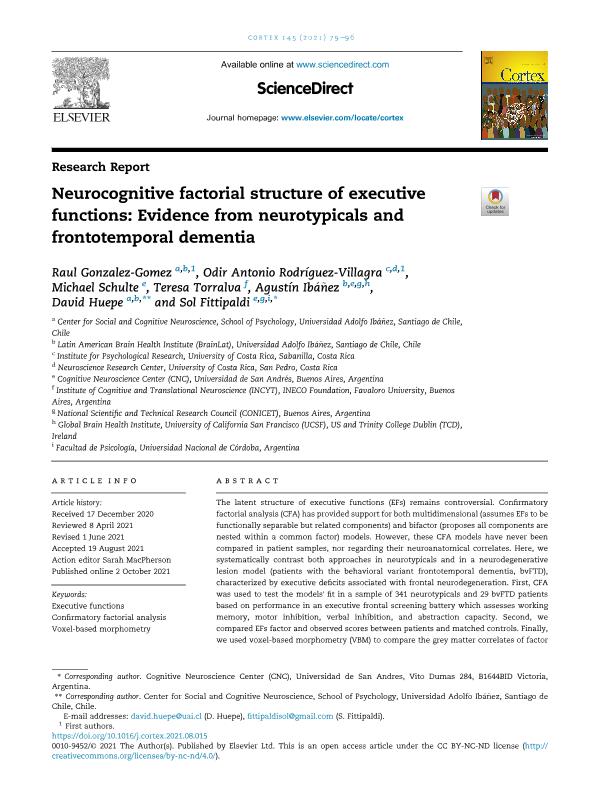Mostrar el registro sencillo del ítem
dc.contributor.author
González Gómez, Raúl
dc.contributor.author
Rodríguez Villagra, Odir Antonio
dc.contributor.author
Schulte, Michael
dc.contributor.author
Torralva, Teresa

dc.contributor.author
Ibañez, Agustin Mariano

dc.contributor.author
Huepe, David
dc.contributor.author
Fittipaldi, María Sol

dc.date.available
2023-08-10T13:21:19Z
dc.date.issued
2021-12
dc.identifier.citation
González Gómez, Raúl; Rodríguez Villagra, Odir Antonio; Schulte, Michael; Torralva, Teresa; Ibañez, Agustin Mariano; et al.; Neurocognitive factorial structure of executive functions: Evidence from neurotypicals and frontotemporal dementia; Elsevier; Cortex; 145; 12-2021; 79-96
dc.identifier.issn
0010-9452
dc.identifier.uri
http://hdl.handle.net/11336/207779
dc.description.abstract
The latent structure of executive functions (EFs) remains controversial. Confirmatory factorial analysis (CFA) has provided support for both multidimensional (assumes EFs to be functionally separable but related components) and bifactor (proposes all components are nested within a common factor) models. However, these CFA models have never been compared in patient samples, nor regarding their neuroanatomical correlates. Here, we systematically contrast both approaches in neurotypicals and in a neurodegenerative lesion model (patients with the behavioral variant frontotemporal dementia, bvFTD), characterized by executive deficits associated with frontal neurodegeneration. First, CFA was used to test the models' fit in a sample of 341 neurotypicals and 29 bvFTD patients based on performance in an executive frontal screening battery which assesses working memory, motor inhibition, verbal inhibition, and abstraction capacity. Second, we compared EFs factor and observed scores between patients and matched controls. Finally, we used voxel-based morphometry (VBM) to compare the grey matter correlates of factor and observed scores. CFA results showed that both models fit the data well. The multidimensional model, however, was more sensitive than the bifactor model and the observed scores to detect EFs impairments in bvFTD patients. VBM results for the multidimensional model revealed common and unique grey matter correlates for EFs components across prefrontal-insular, posterior, and temporal cortices. Regarding the bifactor model, only the common factor was associated with prefrontal-insular hubs. Observed scores presented scant, non-frontal grey matter associations. Converging behavioral and neuroanatomical evidence from healthy populations and a neurodegenerative model of EFs supports an underlying multidimensional structure.
dc.format
application/pdf
dc.language.iso
eng
dc.publisher
Elsevier

dc.rights
info:eu-repo/semantics/openAccess
dc.rights.uri
https://creativecommons.org/licenses/by-nc-nd/2.5/ar/
dc.subject
BVFTD
dc.subject
CONFIRMATORY FACTORIAL ANALYSIS
dc.subject
EXECUTIVE FUNCTIONS
dc.subject
LESION MODEL
dc.subject
VOXEL-BASED MORPHOMETRY
dc.subject.classification
Neurociencias

dc.subject.classification
Medicina Básica

dc.subject.classification
CIENCIAS MÉDICAS Y DE LA SALUD

dc.title
Neurocognitive factorial structure of executive functions: Evidence from neurotypicals and frontotemporal dementia
dc.type
info:eu-repo/semantics/article
dc.type
info:ar-repo/semantics/artículo
dc.type
info:eu-repo/semantics/publishedVersion
dc.date.updated
2023-08-09T12:49:05Z
dc.journal.volume
145
dc.journal.pagination
79-96
dc.journal.pais
Países Bajos

dc.journal.ciudad
Amsterdam
dc.description.fil
Fil: González Gómez, Raúl. Universidad Adolfo Ibañez; Chile
dc.description.fil
Fil: Rodríguez Villagra, Odir Antonio. Universidad de Costa Rica; Costa Rica
dc.description.fil
Fil: Schulte, Michael. Universidad de San Andrés; Argentina
dc.description.fil
Fil: Torralva, Teresa. Consejo Nacional de Investigaciones Científicas y Técnicas. Oficina de Coordinación Administrativa Houssay. Instituto de Neurociencia Cognitiva. Fundación Favaloro. Instituto de Neurociencia Cognitiva; Argentina
dc.description.fil
Fil: Ibañez, Agustin Mariano. Consejo Nacional de Investigaciones Científicas y Técnicas; Argentina. Universidad Adolfo Ibañez; Chile. University of California; Estados Unidos. Universidad de San Andrés; Argentina. Trinity College; Irlanda
dc.description.fil
Fil: Huepe, David. Universidad Adolfo Ibañez; Chile
dc.description.fil
Fil: Fittipaldi, María Sol. Consejo Nacional de Investigaciones Científicas y Técnicas. Oficina de Coordinación Administrativa Houssay. Instituto de Neurociencia Cognitiva. Fundación Favaloro. Instituto de Neurociencia Cognitiva; Argentina. Universidad de San Andrés; Argentina. Universidad Nacional de Córdoba; Argentina
dc.journal.title
Cortex

dc.relation.alternativeid
info:eu-repo/semantics/altIdentifier/url/https://www.sciencedirect.com/science/article/pii/S0010945221003117
dc.relation.alternativeid
info:eu-repo/semantics/altIdentifier/doi/http://dx.doi.org/10.1016/j.cortex.2021.08.015
Archivos asociados
